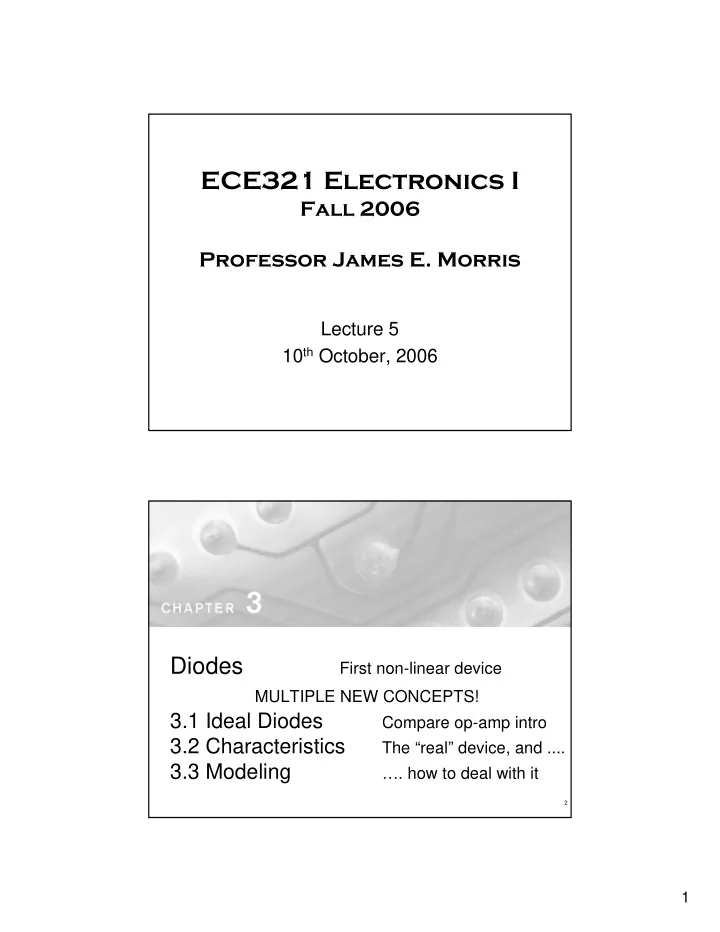

ECE321 Electronics I Fall 2006 Professor James E. Morris Lecture 5 10 th October, 2006 Diodes First non-linear device MULTIPLE NEW CONCEPTS! 3.1 Ideal Diodes Compare op-amp intro 3.2 Characteristics The “real” device, and .... 3.3 Modeling …. how to deal with it 2 1
Figure 3.1 The ideal diode: (a) diode circuit symbol; (b) i–v characteristic; (c) equivalent circuit in the reverse direction; (d) equivalent circuit in the forward direction. Figure 3.2 The two modes of operation of ideal diodes and the use of an external circuit to limit the forward current (a) and the reverse voltage (b) . 2
Figure 3.3 (a) Rectifier circuit. (b) Input waveform. (c) Equivalent circuit when v I ≥ 0. (d) Equivalent circuit when v I � 0. (e) Output waveform. Figure E3.1 3
Figure E3.2 Figure 3.4 Circuit and waveforms for Example 3.1. 4
Figure 3.5 Diode logic gates: (a) OR gate; (b) AND gate (in a positive-logic system). Figure 3.6 Circuits for Example 3.2. 5
Figure E3.4 Figure E3.5 6
Figure 3.7 The i–v characteristic of a silicon junction diode. Figure 3.8 The diode i–v relationship with some scales expanded and others compressed in order to reveal details. 7
Figure 3.9 Illustrating the temperature dependence of the diode forward characteristic. At a constant current, the voltage drop decreases by approximately 2 mV for every 1 ° C increase in temperature. Figure E3.9 8
Figure 3.10 A simple circuit used to illustrate the analysis of circuits in which the diode is forward conducting. Figure 3.11 Graphical analysis of the circuit in Fig. 3.10 using the exponential diode model. 9
Figure 3.12 Approximating the diode forward characteristic with two straight lines: the piecewise-linear model. Figure 3.13 Piecewise-linear model of the diode forward characteristic and its equivalent circuit representation. 10
Figure 3.14 The circuit of Fig. 3.10 with the diode replaced with its piecewise-linear model of Fig. 3.13. Figure 3.15 Development of the constant-voltage-drop model of the diode forward characteristics. A vertical straight line (B) is used to approximate the fast-rising exponential. Observe that this simple model predicts V D to within ± 0.1 V over the current range of 0.1 mA to 10 mA. 11
Figure 3.16 The constant-voltage-drop model of the diode forward characteristics and its equivalent-circuit representation. Figure E3.12 12
Figure 3.17 Development of the diode small-signal model. Note that the numerical values shown are for a diode with n = 2. Figure 3.18 (a) Circuit for Example 3.6. (b) Circuit for calculating the dc operating point. (c) Small-signal equivalent circuit. 13
Figure 3.19 Circuit for Example 3.7. Figure E3.16 14
Table 3.1 Modeling the Diode Forward Characteristic Table 3.1 (Continued) 15
Recommend
More recommend